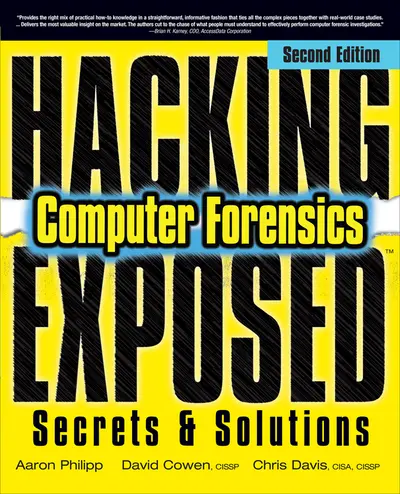My Account Details

ISBN10: 0071626778 | ISBN13: 9780071626774

Step 1 . Download Adobe Digital Editions to your PC or Mac desktop/laptop.
Step 2. Register and authorize your Adobe ID (optional). To access your eBook on multiple devices, first create an Adobe ID at account.adobe.com. Then, open Adobe Digital Editions, go to the Help menu, and select "Authorize Computer" to link your Adobe ID.
Step 3. Open Your eBook. Use Adobe Digital Editions to open the file. If the eBook doesn’t open, contact customer service for assistance.
Publisher's Note: Products purchased from Third Party sellers are not guaranteed by the publisher for quality, authenticity, or access to any online entitlements included with the product.
The latest strategies for investigating cyber-crime
Identify and investigate computer criminals of all stripes with help from this fully updated. real-world resource. Hacking Exposed Computer Forensics, Second Edition explains how to construct a high-tech forensic lab, collect prosecutable evidence, discover e-mail and system file clues, track wireless activity, and recover obscured documents. Learn how to re-create an attacker's footsteps, communicate with counsel, prepare court-ready reports, and work through legal and organizational challenges. Case studies straight from today's headlines cover IP theft, mortgage fraud, employee misconduct, securities fraud, embezzlement, organized crime, and consumer fraud cases.
- Effectively uncover, capture, and prepare evidence for investigation
- Store and process collected data in a highly secure digital forensic lab
- Restore deleted documents, partitions, user activities, and file systems
- Analyze evidence gathered from Windows, Linux, and Macintosh systems
- Use the latest Web and client-based e-mail tools to extract relevant artifacts
- Overcome the hacker's anti-forensic, encryption, and obscurity techniques
- Unlock clues stored in cell phones, PDAs, and Windows Mobile devices
- Prepare legal documents that will hold up to judicial and defense scrutiny
Need support? We're here to help - Get real-world support and resources every step of the way.